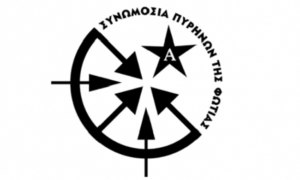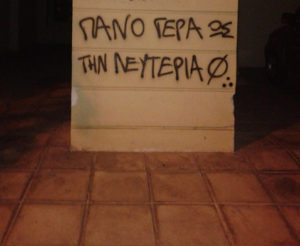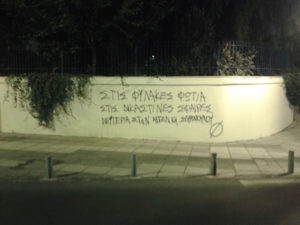
Here is a text that several imprisoned members of the Conspiracy of Cells of Fire in Athens, Greece, wrote for an event at the squatted anarchist centre Bibloteca Kaos in Brazil.
To all comrades, to all our anarchist brothers and sisters who are present in this event organized by the anarchist library Kaos. Let our thoughts break out and travel to Brazil so as to send these few words with the hope that maybe a little, you can feel our presence beside you.
In response to the subject of the event taking place during the International Week of Solidarity with Anarchist Prisoners and on the case of Nicola Sacco and Bartholemeo Vanzetti we would like to throw in our personal and historical contribution. The Conspiracy of Cells of Fire was from the very beginning an anarchist group of direct action that aspired to an upsurge of the anarchist aggressive presence in Greece. Thus, the CCF did not hesitate to often criticize that which was believed to be preventing the generalization of this intensification. But when the oppression finally made it to our doorstep, we fully understood that we would not own up to our standards should we refuse to defend our identity, our political viewpoints and our very substance. Furthermore we could have ended up being in complete contrast with our critiques against others in the past. So seven years after the day that repression struck us, we remain at the forefront of anarchist dignity, at least so as we perceive it. We refused to dishonor ourselves in any way and defended what we believed we had to defend, still paying the price of our uncompromising attitude.
Going back to the past in a time when two comrades, anarchists of praxis forged in the fire of revolt, Nicola Sacco and Bartholomeo Vanzetti were arrested with the charges of armed expropriation and murder, we face challenges not in the least unprecedented. A fact which accrues by ample evidence is that both Sacco and Vanzetti, participated in informal militant networks of anarchist affinity all of which were affiliated to publications such as the anarchist newspaper Cronaca Sovversiva, in whose publishing they helped themselves, and which supported the need of propaganda by praxis. It is also known that these informal militant networks were responsible for a series of attacks that shook the United States from 1914 onwards and that they were being funded by armed expropriations. Finally, it is a fact that some of the comrades of Sacco and Vanzetti have confided, after the murder of the two comrades, that they were two of the five robbers of the shoe factory in Braintree, Massachusetts. One of Sacco and Vanzetti’s comrades Mario Buda, for example, in an interview, when asked about the financing of his team he responded, “We would usually go and take them (the money) from where they could be found”, meaning the banks and factories. Many years later, in 1955, he received a visit from the anarchist Charles Poggi who was investigating historically the case of Sacco and Vanzetti. In the discussion between them, Buda admitted at least to the participation of Sacco in the robbery in Braintree with the phrase “Sacco was there” (“Sacco c’ era”). Poggi had the impression that Buda was one of the robbers as well, but due to his discretion he didn’t raise the issue.
The two comrades were arrested after a chase and although armed, without the technique of ballistic investigation, which hadn’t been perfected at that time, there was no incriminating evidence against them since all the witnesses could not testify to anything reliable. Thus both comrades chose to defend themselves declaring they were innocent of the robbery, yet guilty as anarchists, at a time, when as little as this is, could be enough proof for someone to be prosecuted, tortured, imprisoned or even deported, as the wave of anarchist attacks that rocked the US had caused the state to take emergency measures against anarchists and anarchist immigrants with a series of laws.
At the highlight of the anti-anarchist hysteria which was baptized Red Scare, the two comrades tried to balance on a thin line as to both avoid the death penalty, and maintain their dignity, since they stubbornly refused to forfeit their identity despite the fact that this alone could prove sufficiently condemning.
Unfortunately the case of Sacco and Vanzetti is solely remembered today, as a prime example of government fabrication. The historical narrative that has prevailed, is attempting to cast a veil over the broader historical context of the era in which the prosecution of two comrades enveloped, and deliberately mislead portraying them merely as organized unionists, when Sacco and Vanzetti and nearly all the comrades aroundCronaca Sovversiva had deeply anti-formalist feelings, distancing themselves from the official anarchist organizations.
Ultimately the case of the two comrades, has been degraded into a story that elevates the value of victimization, instead of being a timeless example of proud anarchist insurrection. Such a theme is hardly unknown even to this day. Naturally every comrade always retains the right not to give away even an ounce of himself to the enemy, especially when they have insufficient evidence -if any- to convict him or her.
Yet that is one thing, whilst the political fetishism of victimization, that deliberately and utterly forgets those who choose to personally defend their militant commitment to anarchy, is another. And if one is in doubt, let them wonder as to why the names of Sacco and Vanzetti’s comrades are to be cast into oblivion. For how many still remember or know even, about the ‘dynamite-girl’, the 19-year old comrade Gabriella Antollini, who claimed responsibility for transporting weapons and explosives? How many remember Nicola Recci who lost almost all of his hand while manufacturing explosive devices? How often is Carlo Valdinoci mentioned, who died by a bomb explosion that he was planning to plant in the house of the Minister of Justice Palmer; or Andrea Salsedo, who was thrown out of a window by cops during an interrogation about a claim of responsibility that was discovered in his print shop? All of these and many more, were destined to be left out of the history books, because as it happens, they were not “innocent”.
At this point, we have to stress that Sacco and Vanzetti, despite declaring themselves innocent of all accusations, never did they denounce their insurrectionary heritage. A fact proved by the number of offensive actions throughout the world made as an indication of solidarity to both comrades. From the bombing, using a wired car, of Wall Street to the parcel bomb sent to the US ambassador in Paris, as well as dozens of bombings of American embassies in a number of countries. The comrades would often themselves urge the movement to retaliations against the state and judges. In June 1926 in an issue of Protesta Umana Vanzetti wrote among other things: “I will try to see Thayer dead before his announcement of our sentence” and asked fellow comrades for “revenge, revenge in our name and in the names of our living and our dead.” The article concluded with “Health Is In You” which was the title of a manual about explosive devices published by Cronaca Sovversiva (some say translated by Emma Goldman herself).
Even to this day, the rich contribution of insurrectionary anarchy in the solidarity movement with Sacco and Vanzetti, is largely neglected. On an occasion such as the call for the International Week of Action for Imprisoned Anarchists the legacy of such militant solidarity is definitely worth remembering in its whole perspective. Anyone who believes the dissociation with militant acts of solidarity is new or lacks roots, is deeply mistaken. A noteworthy fact is that, all the while certain anarchist circles in Argentina slanderedSeverino Di Giovanni, accusing him even of being a fascist, Sacco’s widow in a correspondence a few days after the execution of both comrades expressed her gratitude for his support to their case. In the same letter she indicated that the director of a certain firm of cigarettes named “Combinador” had offered to give to a particular kind of cigarettes the brand “Sacco and Vanzetti”, shamelessly trying to make profit from the notoriety of their case. On November 26, 1927 a bomb planted by Di Giovanni and his comrades blew up a branch of said company in Buenos Aires. Part of the very same group was the comrade of Sacco and Vanzetti, Ferrecio Coacci, who had since been deported from the US. Coacci was also a suspect in the robbery for which Sacco and Vanzetti were convicted and his house was the very first to be raided in regards with the case investigation.
We hope these few words to incite interest to those attending the event, and set the grounds for an authentic and comradely discussion on all aforementioned issues since unfortunately, we are doomed to learn nothing of our history, thus condemning ourselves to the same mistakes time and again .
From the heart, we send to all of you, our warmest greetings.
For the end we ought to remind ourselves the phrase of anarchist Luigi Galleani, comrade of Sacco and Vanzetti and one of the publishers of Cronaca Sovversiva:
“No act of rebellion is useless; no act of rebellion is harmful.”
The members of Conspiracy of Cells of Fire
Michalis Nikolopoulos
Giorgos Nikolopoulos
Haris Hatzimihelakis
Panagiotis Argirou
Theofilos Mavropoulos
Damiano Bolano
(via 325)












